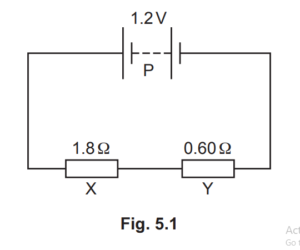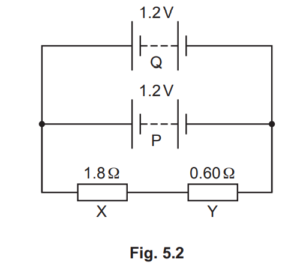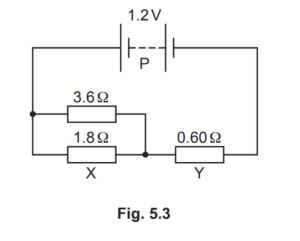Question
(a) State Kirchhoff’s first law. [2]
(b) The circuit shown in Fig. 5.1 contains a battery of electromotive force (e.m.f.) E and negligible
internal resistance connected to four resistors R1, R2, R3 and R4, each of resistance R.

The current in R3 is 0.30A and the potential difference (p.d.) across R4 is 2.4V.
(i) Show that R is equal to 4.0Ω. [2]
(ii) Determine the e.m.f. E of the battery.
E = ……………………………………………… V [2]
(c) The battery in (b) is replaced with another battery of the same e.m.f. E but with an internal
resistance that is not negligible.
State and explain the change, if any, in the total power produced by the battery. [2]
(d) The resistors in the circuit of Fig. 5.1 are made from nichrome wire of uniform radius 240μm.
The length of this wire needed to make each resistor is 0.67m.
Calculate the resistivity of nichrome.
resistivity = ………………………………………….. Ωm [3]
[Total: 11]
Answer/Explanation
(a) sum of current(s) in = sum of current(s) out
or
(algebraic) sum of current(s) is zero
at a junction (in a circuit) A1
(b) (i) (current in R4 or R1 =) 0.30 + 0.30
(= 0.60A)
(R =) 2.4 / 0.60 = 4.0 (Ω) A1
or
(p.d. across R3 or R2 =) 2.4 / 2
(= 1.2 V)
(R =) 1.2 / 0.30 = 4.0 (Ω)
(b) (ii) E = 2.4 + 2.4 + 1.2 C1
= 6.0 V A1
or
total resistance = 10 (Ω)
E = 10 × 0.60 = 6.0 V
(c) total resistance increases
current decreases (in battery) so total power decreases
(d) resistivity = RA / L
= 4.0 × π × (240 × 10–6)2 / 0.67
= 1.1 × 10–6 Ω m
Question
(a) Define the ohm.
…………………………………………………………………………………………………………………………………
…………………………………………………………………………………………………………………………………
…………………………………………………………………………………………………………………………………
(b) A wire has a resistance of 1.8Ω. The wire has a uniform cross-sectional area of 0.38mm2 and is made of metal of resistivity 9.6 × 10–7Ωm.
Calculate the length of the wire.
length = …………………………………………….. m
(c) A resistor X of resistance 1.8Ω is connected to a resistor Y of resistance 0.60Ω and a battery P, as shown in Fig. 5.1.

The battery P has an electromotive force (e.m.f.) of 1.2V and negligible internal resistance.
(i) Explain, in terms of energy, why the potential difference (p.d.) across resistor X is less
than the e.m.f. of the battery.
………………………………………………………………………………………………………………………….
………………………………………………………………………………………………………………………….
………………………………………………………………………………………………………………………….
(ii) Calculate the potential difference across resistor X.
potential difference = ……………………………………………… V
(d) Another battery Q of e.m.f. 1.2V and negligible internal resistance is now connected into the circuit of Fig. 5.1 to produce the new circuit shown in Fig. 5.2.

State whether the addition of battery Q causes the current to decrease, increase or remain
the same in:
(i) resistor X ………………………………………………………………………………………………………
(ii) battery P. ………………………………………………………………………………………………………
(e) The circuit shown in Fig. 5.2 is modified to produce the new circuit shown in Fig. 5.3.

Calculate:
(i) the total resistance of the two resistors connected in parallel
resistance = …………………………………………….. Ω
(ii) the current in resistor Y.
current = ……………………………………………… A
Answer/Explanation
(a)
volt / ampere
(b)
R = ρL / A
L = (1.8 × 0.38 × 10–6) / 9.6 × 10–7
= 0.71 m
(c)(i)
thermal energy is dissipated in resistor Y
(c)(ii)
V / 1.2 = 1.8 / (1.8 + 0.6)
V = 0.90 V
or
I = 1.2 / (1.8 + 0.6) (= 0.50)
V = 0.50 × 1.8
= 0.90 V
(d)
remain the same
decrease
(e)
1 / R = 1 / 1.8 + 1 / 3.6
R = 1.2 Ω
I = 1.2 / (1.2 + 0.60)
= 0.67 A
or
VY = 1.2 × 0.60 / (1.2 + 0.60) (= 0.40)
I = 0.40 / 0.60
= 0.67 A
